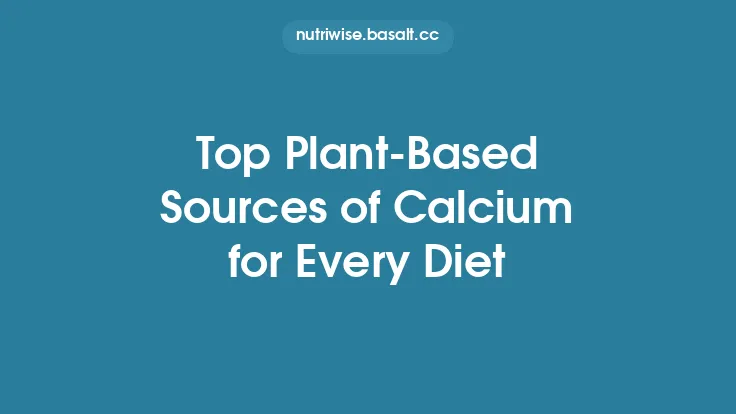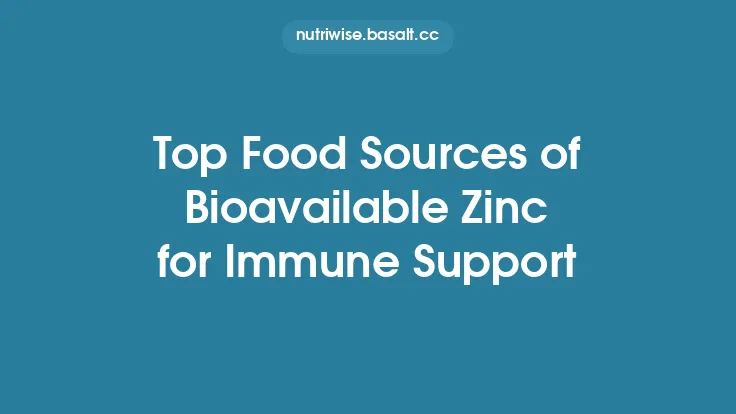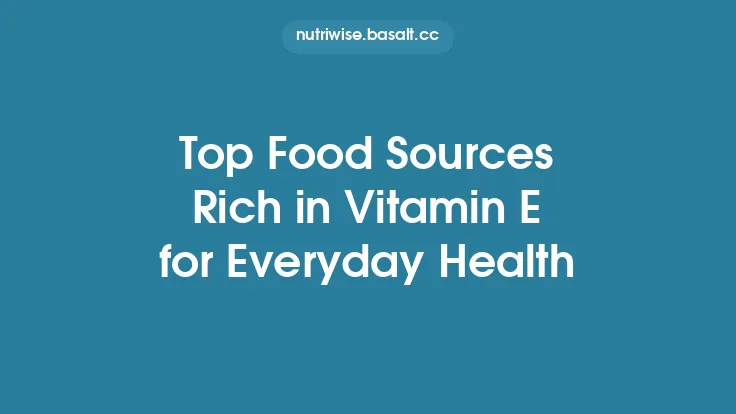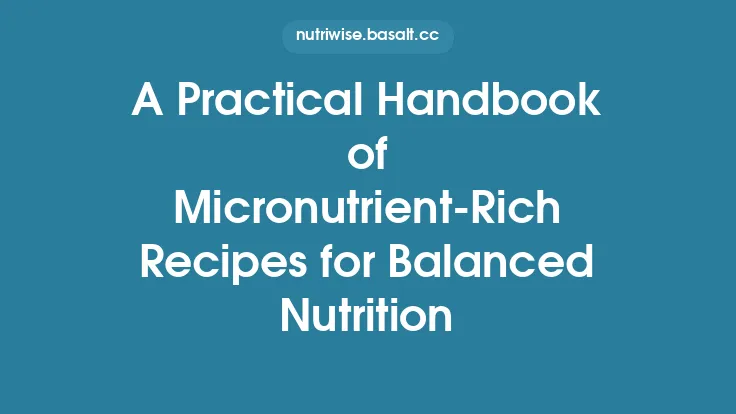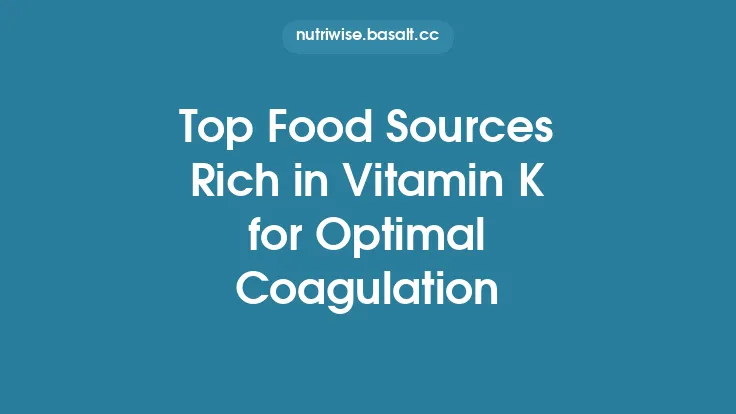Iron is an essential mineral that supports oxygen transport, energy production, and cellular metabolism. Ensuring a steady supply of iron through the foods you eat is a cornerstone of a balanced diet, especially because the body cannot produce this nutrient on its own. While the amount of iron needed varies among individuals, incorporating a variety of iron‑rich foods can help maintain adequate stores and support overall health. Below is a comprehensive guide to the top food sources of iron, organized by category and accompanied by practical information on serving sizes, typical iron content, and considerations for maximizing the benefit of each source.
Animal‑Based Sources: Heme Iron Powerhouses
Why they matter
Heme iron, found exclusively in animal tissues, is bound within the porphyrin ring of hemoglobin and myoglobin. This molecular structure makes heme iron highly bioavailable—generally 15–35 % of the iron in these foods is absorbed, regardless of other dietary factors.
| Food (cooked) | Typical Serving Size | Iron Content (mg) |
|---|---|---|
| Beef liver | 85 g (3 oz) | 5.0–6.5 |
| Lean beef (ground, 90 % lean) | 85 g (3 oz) | 2.1–2.7 |
| Lamb shoulder, roasted | 85 g (3 oz) | 1.8–2.3 |
| Pork tenderloin, roasted | 85 g (3 oz) | 0.9–1.2 |
| Chicken thigh, skinless, roasted | 85 g (3 oz) | 0.9–1.1 |
| Turkey breast, roasted | 85 g (3 oz) | 0.7–0.9 |
Practical tips
- Choose lean cuts to limit saturated fat while still obtaining iron.
- Incorporate organ meats like liver a few times per month; they deliver a concentrated iron dose with a modest caloric load.
- When cooking, avoid over‑cooking meat, as prolonged high heat can cause iron loss into cooking juices. Retain those juices in sauces or gravies to preserve the mineral.
Seafood Selections Rich in Iron
Key contributors
Seafood provides both heme iron and, in some species, appreciable amounts of non‑heme iron. Shellfish, in particular, are notable for their iron density.
| Food (cooked) | Typical Serving Size | Iron Content (mg) |
|---|---|---|
| Clams, steamed | 85 g (3 oz) | 3.5–4.0 |
| Oysters, baked | 85 g (3 oz) | 3.0–3.5 |
| Mussels, steamed | 85 g (3 oz) | 2.5–3.0 |
| Sardines, canned in oil | 85 g (3 oz) | 2.0–2.5 |
| Tuna, light canned in water | 85 g (3 oz) | 0.8–1.0 |
| Shrimp, boiled | 85 g (3 oz) | 0.5–0.7 |
Practical tips
- Include a serving of shellfish (e.g., clams or mussels) once or twice weekly for a substantial iron boost.
- Canned fish can be a convenient pantry staple; choose varieties packed in water or oil without added sodium.
- When preparing seafood, steam or bake rather than deep‑fry to retain nutrients and keep the dish heart‑healthy.
Plant‑Based Sources: Non‑Heme Iron Options
Understanding the category
Non‑heme iron is present in plant foods and is bound to compounds such as phytates and polyphenols, which can modestly reduce its absorption. Nevertheless, plant sources are indispensable for those following vegetarian or flexitarian patterns and contribute valuable fiber, antioxidants, and other micronutrients.
| Food (raw or cooked) | Typical Serving Size | Iron Content (mg) |
|---|---|---|
| Spinach, cooked | ½ cup (90 g) | 3.2–3.6 |
| Swiss chard, cooked | ½ cup (90 g) | 2.0–2.4 |
| Kale, raw | 1 cup (67 g) | 1.0–1.2 |
| Broccoli, cooked | ½ cup (78 g) | 0.6–0.8 |
| Beet greens, cooked | ½ cup (90 g) | 1.5–1.8 |
| Pumpkin seeds, roasted | ¼ cup (30 g) | 2.5–3.0 |
Practical tips
- Pair leafy greens with a modest amount of healthy fat (e.g., olive oil) to improve overall nutrient uptake.
- Incorporate a variety of colored vegetables throughout the week to diversify iron sources and provide complementary phytonutrients.
- Lightly steaming greens can reduce oxalate content, which may otherwise bind iron.
Legumes and Pulses: Iron‑Dense Staples
Nutrient profile
Legumes are among the most iron‑rich plant foods, delivering both iron and protein. Their iron content is consistent across cooking methods, though soaking and cooking can reduce antinutrient levels.
| Food (cooked) | Typical Serving Size | Iron Content (mg) |
|---|---|---|
| Lentils, brown, boiled | ½ cup (100 g) | 3.3–3.6 |
| Chickpeas, boiled | ½ cup (100 g) | 2.4–2.7 |
| Black beans, boiled | ½ cup (100 g) | 2.1–2.4 |
| Kidney beans, boiled | ½ cup (100 g) | 2.0–2.3 |
| Soybeans, boiled | ½ cup (100 g) | 4.5–5.0 |
| Split peas, boiled | ½ cup (100 g) | 2.5–2.8 |
Practical tips
- Soak dried beans for 8–12 hours, then discard the soaking water before cooking to lower phytate concentration.
- Use legumes as the base for soups, stews, salads, or as a meat substitute in patties and tacos.
- Combine legumes with whole grains (e.g., rice and beans) to create a complete amino acid profile while delivering a robust iron dose.
Nuts, Seeds, and Dried Fruits: Compact Iron Boosters
Convenient options
These foods are portable, shelf‑stable, and can be easily incorporated into snacks, breakfast bowls, or baked goods.
| Food (raw) | Typical Serving Size | Iron Content (mg) |
|---|---|---|
| Pumpkin seeds (pepitas) | ¼ cup (30 g) | 2.5–3.0 |
| Sesame seeds, toasted | 1 tbsp (9 g) | 1.3–1.5 |
| Almonds, raw | ¼ cup (35 g) | 1.0–1.2 |
| Cashews, raw | ¼ cup (30 g) | 1.7–2.0 |
| Dried apricots, unsweetened | ¼ cup (35 g) | 1.0–1.2 |
| Raisins, unsweetened | ¼ cup (40 g) | 0.8–1.0 |
| Prunes, dried | ¼ cup (40 g) | 0.9–1.1 |
Practical tips
- Sprinkle seeds onto salads, yogurt, or oatmeal for an iron‑rich crunch.
- Use nuts and dried fruit as a base for homemade trail mixes, balancing sweet and savory elements.
- Store nuts and seeds in airtight containers in the refrigerator to preserve freshness and prevent oxidation.
Whole Grains and Cereals: Iron in Everyday Staples
Baseline contributions
Whole grains contain iron within the bran and germ layers, which are retained in minimally processed products.
| Food (cooked or prepared) | Typical Serving Size | Iron Content (mg) |
|---|---|---|
| Quinoa, cooked | ½ cup (92 g) | 1.5–1.8 |
| Oats, rolled, cooked | ½ cup (78 g) | 1.2–1.5 |
| Brown rice, cooked | ½ cup (98 g) | 0.5–0.7 |
| Bulgur, cooked | ½ cup (92 g) | 1.0–1.2 |
| Whole‑wheat bread, 2 slices | 60 g | 1.2–1.5 |
| Fortified breakfast cereal | 30 g (1 oz) | 4.5–6.0* |
\*Fortified cereals are specifically enriched with iron; the amount can vary by brand and formulation.
Practical tips
- Choose whole‑grain breads, pastas, and cereals over refined counterparts to capture the natural iron present in the grain’s outer layers.
- When using fortified cereals, read the nutrition label to confirm the iron content and serving size.
- Combine whole grains with legumes in dishes like grain‑and‑bean salads to increase overall iron density.
Fortified Foods: Engineered Iron Content
What they are
Food fortification adds iron (often as ferrous sulfate, ferrous fumarate, or elemental iron powders) to commonly consumed items, ensuring a reliable source of the mineral without altering the food’s primary characteristics.
| Fortified Product | Typical Serving Size | Iron Content (mg) |
|---|---|---|
| Iron‑fortified soy milk | 1 cup (240 ml) | 3.0–4.0 |
| Iron‑fortified orange juice | 1 cup (240 ml) | 2.5–3.5 |
| Iron‑fortified infant formula | 1 cup (240 ml) | 5.0–7.0 |
| Iron‑fortified flour (all‑purpose) | 1 cup (120 g) | 4.0–5.5 |
| Iron‑fortified nutritional bars | 1 bar (45 g) | 3.5–5.0 |
Practical tips
- Incorporate fortified plant‑based milks into smoothies, cereals, or coffee for an easy iron boost.
- Use fortified flours in baking to increase iron content of homemade breads and muffins.
- Verify that the product’s iron source is listed as “ferrous” rather than “elemental iron” for better bioavailability.
Cooking Techniques that Preserve Iron
- Minimal Water Loss – When boiling vegetables, use just enough water to cover them and consider using the cooking liquid in sauces or soups; iron leaches into the water.
- Steaming Over Boiling – Steaming retains more iron (and other micronutrients) compared to prolonged boiling.
- Sautéing in Iron‑Rich Oils – Using a small amount of oil with a high smoke point (e.g., canola or avocado oil) allows quick cooking while preserving iron.
- Cast‑Iron Cookware – Cooking acidic foods (tomato‑based sauces, stews) in seasoned cast‑iron pans can add a modest amount of dietary iron to the final dish.
- Avoid Over‑Roasting – Excessive heat can cause iron to oxidize and become less available; aim for a golden‑brown finish rather than a charred crust.
Balancing Iron Intake Within a Diverse Diet
- Variety is key: Combining animal, seafood, plant, and fortified sources ensures a steady iron supply throughout the week.
- Portion control: While iron‑rich foods are beneficial, some (e.g., organ meats) are also high in cholesterol; balance them with lean proteins and plant foods.
- Complementary nutrients: Although the focus here is on iron sources, a well‑rounded diet that includes adequate protein, B‑vitamins, and minerals supports overall hematologic health.
- Mindful timing: Spacing iron‑dense meals (e.g., a meat‑based lunch and a bean‑rich dinner) can help distribute intake without overwhelming the digestive system.
Practical Tips for Incorporating Iron‑Rich Foods
- Meal‑Prep Strategy
- Cook a batch of lentils or beans on Sunday; store in portion‑size containers for quick addition to salads, wraps, or stir‑fries.
- Roast a tray of mixed vegetables (spinach, kale, beet greens) with a drizzle of olive oil; these can be reheated as side dishes or blended into soups.
- Snack Smart
- Keep a small jar of roasted pumpkin seeds at your desk for an iron‑boosting snack.
- Pair a handful of dried apricots with a slice of whole‑grain toast topped with almond butter for a balanced mini‑meal.
- Breakfast Boost
- Prepare oatmeal with fortified soy milk, stir in a spoonful of chia seeds, and top with sliced banana and a sprinkle of toasted sesame seeds.
- Use a fortified cereal as a base, adding fresh berries and a dollop of Greek yogurt for protein.
- Lunch/Dinner Ideas
- Stir‑Fry: Combine sliced beef strips, broccoli, and bell peppers; finish with a splash of low‑sodium soy sauce and serve over quinoa.
- Seafood Paella: Include clams, mussels, and shrimp with brown rice, tomatoes, and peas for a colorful, iron‑rich entrée.
- Veggie‑Heavy Bowl: Layer cooked brown rice, roasted sweet potatoes, sautéed kale, and a generous scoop of black beans; drizzle with tahini for healthy fats.
- Weekend Treat
- Bake a savory muffin using whole‑wheat flour, fortified with iron, and folded with chopped spinach and feta cheese.
By weaving these foods and strategies into everyday meals, you can maintain a robust iron intake without relying on supplements or drastic dietary overhauls. The key lies in diversity, thoughtful preparation, and an awareness of the natural iron content each food contributes to your plate.
